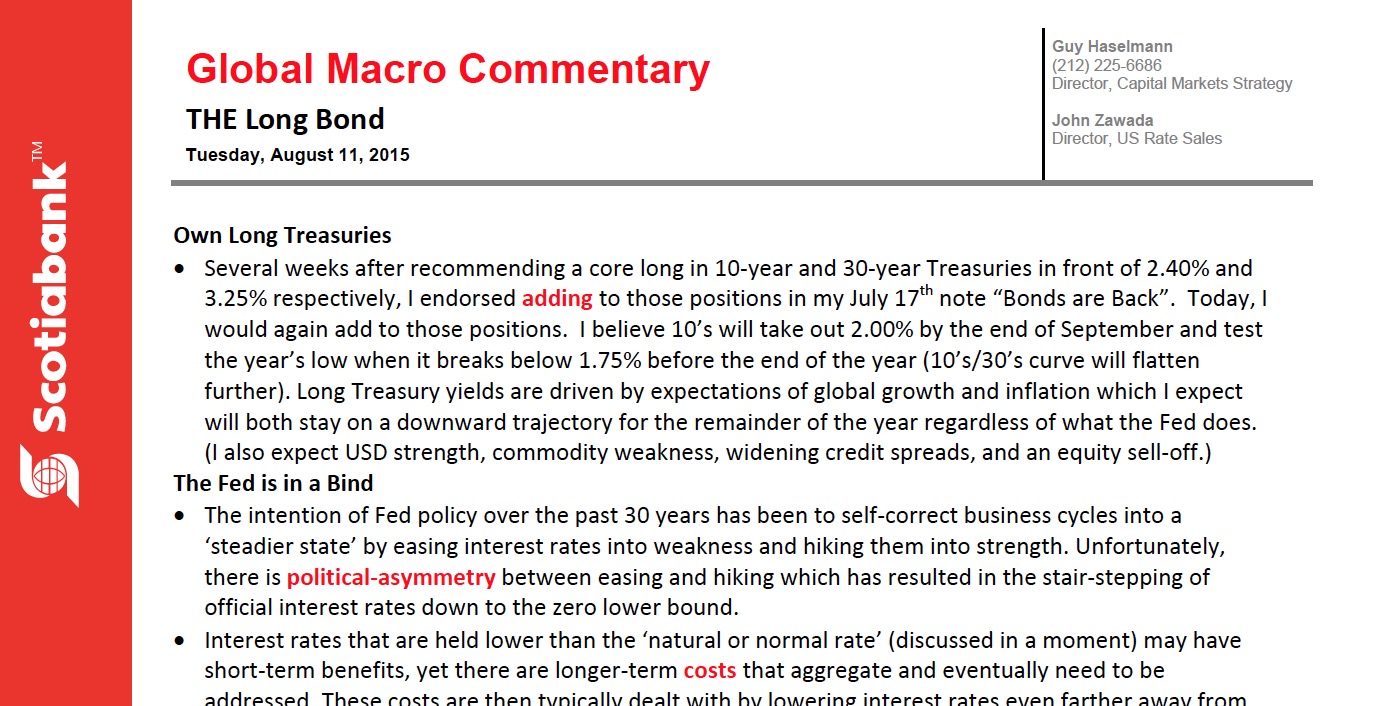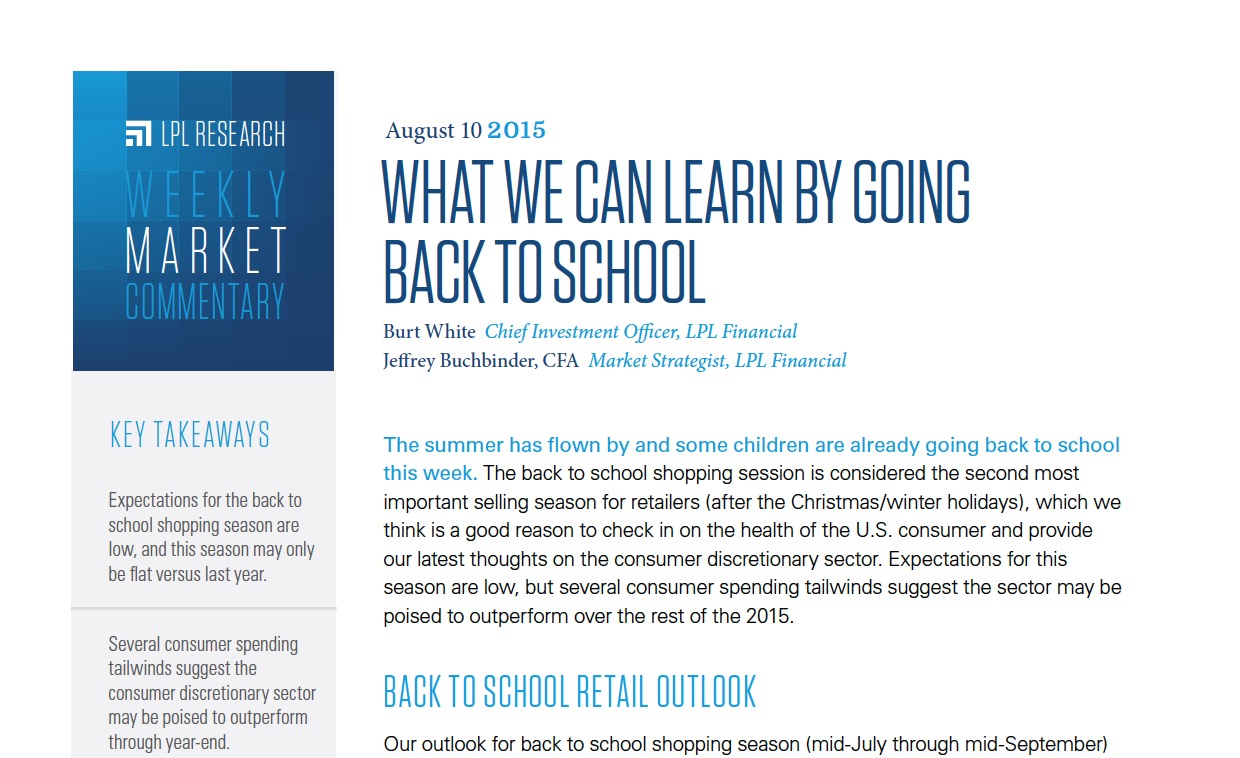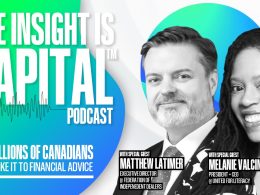Own Long Treasuries
by Guy Haselmann, Director, Capital Markets Strategy, Scotiabank GBM
• Several weeks after recommending a core long in 10-year and 30-year Treasuries in front of 2.40% and 3.25% respectively, I endorsed adding to those positions in my July 17th note “Bonds are Back”. Today, I would again add to those positions. I believe 10’s will take out 2.00% by the end of September and test the year’s low when it breaks below 1.75% before the end of the year (10’s/30’s curve will flatten further). Own long bonds – Long Treasury yields are driven by expectations of global growth and inflation which I expect will both stay on a downward trajectory for the remainder of the year regardless of what the Fed does. (I also expect USD strength, commodity weakness, widening credit spreads, and an equity sell-off.)
The Fed is in a Bind
• The intention of Fed policy over the past 30 years has been to self-correct business cycles into a ‘steadier state’ by easing interest rates into weakness and hiking them into strength. Unfortunately, there is political-asymmetry between easing and hiking which has resulted in the stair-stepping of official interest rates down to the zero lower bound.
• Interest rates that are held lower than the ‘natural or normal rate’ (discussed in a moment) may have short-term benefits, yet there are longer-term costs that aggregate and eventually need to be addressed. These costs are then typically dealt with by lowering interest rates even farther away from the normal or natural rate. Eventually the Fed ends up worsening the very business cycles they intended to smooth out.
• The fact that rates today have reached zero means that the day of reckoning is quickly approaching, because monetary policy has reached the practical limits of what it can do. Thus, the multi-decade credit era is coming to an end.
o Sustainable growth is better for an economy than boom-to-bust cycles. A marathon is won by a distance runner with a steady pace, not by a runner who alternates between sprinting and walking and risking injury.
• Credit-based consumption is unsustainable. US corporate issuance has broken a new record in four successive years. According to David Stockman, the amount of total credit outstanding (household, corporate, government and financial) has expanded by over $50 trillion in the past 30 years, while GDP has expanded by only $13 trillion. In addition, while the whole world has gotten significantly more indebted, it also has terrible demographics to contend with.
• The S&P over this same 30-year period has returned just over 6% adjusted for inflation, while real GDP has been just above 2%. The market has risen 3 times faster than national output in real terms. A sizable equity market correction could happen merely because the bubble-blowing machine is losing its wind. Certainly, the magnitude of the monetary and debt-based fuel that has powered equities in the past will not be available going forward.
• An economy runs most efficiently in the long-run when the price of money, i.e., the official interest rate, does not veer too far from the level where savings and investment can find a clearing price (i.e., the natural rate of interest). This is called the Wicksellian Differential, i.e., the difference between the money rate and natural rate of interest. It postulates that when the natural rate is higher than the money rate, the disequilibrium will drive credit expansion.
• Destructive behavior occurs when the price of money is set too low. When money is cheap, the lure of easy profit becomes too enticing. Money is borrowed for speculation. Since the cost of money falls, borrowed money can be deployed into ever less-productive assets. The objective of borrowed money is to merely outperform one’s borrowing costs.
• Low rates also increase longer run uncertainty, impacting the ability to determine the return of a fixed investment. This is one reason why share buyback, and mergers and acquisitions, have surpassed capital expenditures, and research and development. Investment in the future is too low.
• Low rates lead to asset price inflation, which moves valuations further from their underlying economic fundamentals. As asset prices move higher, they can be used as collateral to push asset prices even higher. However, when the bust eventually unfolds, a negative wealth effect occurs. When the economy and asset prices reverse the effects of the boom, all of the accumulated debt built up during the period of central bank accommodation still remains. The Fed has basically borrowed from the future to improve today.
• This damaging circumstance is a direct result of rates being held too low, allowing for the inefficient use of capital. Furthermore, speculation from cheap money to boost asset prices creates the illusion that everything is better than it really is. This can lead to complacency and poor decision-making. Cheap money also provides the opportunity for over-capacity and over-production which places downward pressure on prices. (See my July 21st note, “Too Much of Everything”).
• There is lopsidedness in the setting of interest rates. The benefits of an interest rate cut to the economy likely works differently when it is at 3% than when it is near 0.25%. It also works differently when it’s been at some level for two quarters, versus the same level for seven years. In addition, the absolute level of rates says little about whether the lender is being adequately compensated and incentivized to lend. In any case, discussion of these factors would complicate Fed communication and even call into question their fallibility. Thus, they are not discussed.
• Nonetheless, I do not believe the Fed’s current dogma that low rates today are necessary for long-run growth or to trigger consumer inflation. How can it, when it is leading to over-capacity and massive global indebtedness? Low rates also allow insolvent companies to continue to exist through the ability to re-finance. Bad companies should be allowed to fail. Creative destruction is beneficial in the long run.
Bottom Line
• Fed policy today and over the past several years may prove to be counter-productive in the long-run.
• Sustainable growth is best served by an interest rate where capital is deployed efficiently. The long-run consequences of policy during the past few years could easily mean lower long-run potential growth and inflation. Today’s consumption and market speculation was paid for with huge amounts of accumulated debt. Tomorrow’s revenues will have to be steered toward servicing that debt. Future revenue will also have to replenish the deficient levels of R&D and infrastructure investment of the past few years.
China
• The Chinese Yuan devaluation will increase currency war tendencies that have subtlety existed in the past few years. Beijing is trying to balance increasing exports with limiting capital outflows. Unfortunately, outflows happen quickly, while exports develop more slowly over time. The devaluation will destabilize China’s financial problems further. If Beijing was really in control as some suggest, then officials would not be in the position of having to implement so many extreme policy responses.
• This action further complicates the FOMC’s argument. More importantly, it will hurt US corporate earnings and cause a decrease in expectations for global growth and inflation, which will, in turn, benefit long Treasuries.
“The highway’s jammed with broken heroes on a last-chance power drive” – Bruce Springsteen
Regards,
Guy
Guy Haselmann | Capital Markets Strategy
▬▬▬▬▬▬▬▬▬▬▬▬▬▬▬▬▬▬▬▬▬▬▬▬▬▬▬
Scotiabank | Global Banking and Markets
250 Vesey Street | New York, NY 10281
T-212.225.6686 | C-917-325-5816
guy.haselmann[at]scotiabank.com
Scotiabank is a business name used by The Bank of Nova Scotia
Copyright © Scotiabank GBM













